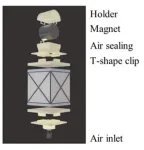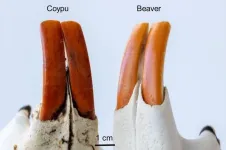(Press-News.org) The electromyographic(EMG) signal is the bioelectrical current generated during muscle contraction. It can be transmitted as an input signal to an intelligent bionic prosthetic hand to control hand movements. By increasing the number of signal acquisition channels, richer information about the intention of the action can be captured, thus improving the success rate of the recognition of the intention of the action. However, it is not better to have more acquisition channels. As the number of channels increases, the hardware system becomes more complex, and the effect of improving the accuracy of gesture recognition gradually decreases, resulting in the control effect reaching a bottleneck.
To address these issues, a team of researchers from Beijing Institute of Technology proposed a method to improve gesture recognition accuracy by virtually increasing the number of EMG signal channels.
The team published their findings in Cyborg and Bionic Systems on Jan 29, 2024.
This method extracts amplitude features from EMG signals to represent the contraction intensity of a muscle over time. The absolute values of the intensity differences between channels are then calculated. These difference values are merged with the original data to form new samples with more columns, simulating an actual increase in the dimensionality of the data. This makes use of the implicit coordination information between muscles during movement. Even if the number of physical acquisition channels is limited, this approach improves recognition accuracy because it does not rely solely on the amount of data directly acquired by the sensor.
To validate their method, the authors compared the accuracy of gesture intent recognition before and after adding virtual dimensions. The accuracy of gesture recognition using EMG signals after the addition of virtual dimensions was improved compared to unprocessed EMG signals. In addition, the greater the number of EMG signal acquisition channels and the richer the EMG signals obtained, the higher the success rate of gesture recognition.
In addition, based on the filtered feature selection approach, the research team introduced a separability metric derived from the dispersion and correlation of the feature set (separability of feature vectors SFV). The SFV value can predict the classification effect before classification is performed and validate the effectiveness of the virtual dimensionality increase strategy in terms of the change in the separability of the feature set.
Authors of the paper include Yuxuan Wang, Ye Tian, Jinying Zhu, Haotian She, Yinlai Jiang, Zhihong Jiang, and Hiroshi Yokoi
The paper, "A Hand Gesture Recognition Strategy Based on Virtual-Dimension Increase of EMG" was published in the journal Cyborg and Bionic Systems on Jan 29, 2024, at DOI: https://doi.org/10.34133/cbsystems.0066
Reference
Authors: Yuxuan Wang 1, Ye Tian 1, Jinying Zhu 1, Haotian She 1, Yinlai Jiang 2, Zhihong Jiang 1, and Hiroshi Yokoi 2
Title of original paper: A Hand Gesture Recognition Strategy Based on Virtual-Dimension Increase of EMG
Journal: Cyborg and Bionic Systems
DOI: 10.34133/cbsystems.0066
Affiliations:
1School of Mechatronical Engineering, Beijing Institute of Technology, Beijing, 100081, China.
2Faculty of Informatics and Engineering, The University of Electro-Communications, Tokyo, Japan.
END
Virtual-dimension increase of EMG signals for prosthetic hands gesture recognition
2024-04-17
ELSE PRESS RELEASES FROM THIS DATE:
Magneto-pneumatic hybrid-driven soft actuator with bidirectional torsion
2024-04-17
The ability of the human wrist to rotate around the forearm axis in 2 directions is crucial for many daily activities. This rotation, limited to a range of approximately [-90°, 90°], restricts the wrist's capacity to execute complex operational tasks. For example, when we open or lock a door with a key, our wrist performs a large rotational movement. When we screw, the wrist needs to twist 180° several times. However, due to the limited rotation angle, the hand needs to leave the key or screwdriver several times to complete the entire work process. In order to realize large rotation ratio in a single actuator, a research team from Zhejiang ...
One million US dollars for mapping the “springs of the spinal fluid”
2024-04-17
A research team at DZNE has been awarded around one million US dollars for the development of an innovative, AI-based method to measure the “choroid plexus” three-dimensionally in human brain scans. These finely branched brain structures are the main sources of the “cerebrospinal fluid” and thus of great significance for the function of the brain and spinal cord. It is also assumed that they play a role in various neurological diseases, including Alzheimer’s. The research project is funded by the US National Institutes of Health (NIH).
The “cerebrospinal fluid” (CSF) is ...
Challenges in Greenland marine research and insights and priorities for development of East Greenland marine and coastal environments
2024-04-17
This report presents gained knowledge identified at two events during the Greenland Science Week on the 7th of November 2023 in Nuuk, Greenland:
The 1st Biennial Greenland Marine Research Seminar and
The workshop on Status and Development for East Greenland Waters
Both events had a forward-looking focus, to gain insight and knowledge from stakeholders and other parties, to be implemented in future research. The marine research seminar also served as a follow-up on earlier ECOTIP and Face-It stakeholder involvement in Greenland and was an opportunity to share project results and recommendations ...
Copper beads in pig feed reshape swine gut microbiome
2024-04-17
Highlights:
In lab experiments, copper shows antimicrobial properties, including against pathogens like Salmonella.
Copper beads in animal feeds may improve gut health in pigs.
A new bead design effectively delivers copper to the lower intestine.
New findings show copper beads influence the microbial makeup in a pig’s gut, but more work is needed to optimize the benefits.
Washington, D.C. — April 17, 2024 — Copper is a natural antimicrobial material that, when added to pig feed, may promote the growth and ...
FAU Engineering selected by NASA for University Nanosatellite Program
2024-04-17
Florida Atlantic University’s College of Engineering and Computer Science is among eight university teams in the United States selected to work with NASA and the U.S. military to foster innovation and expertise in the small satellite sector.
NASA’s CubeSat Launch Initiative (CSLI) is partnering with the U.S. Air Force and U.S. Space Force for the 2024 Mission Concept Program. A CubeSat is among a class of research spacecraft called nanosatellites about the size of a 4-inch cube and typically weighing less than 5 pounds.
Running from May through August, the University Nanosatellite ...
Nursing resources affect hospital patient experience ratings
2024-04-17
Waltham — April 10, 2024 — The nursing work environment, nurse education, and staffing levels are independent factors affecting hospital scores on a key measure of patient-centered care – with significant implications for reimbursements, reports a study in Medical Care. The journal is published in the Lippincott portfolio by Wolters Kluwer.
"Our results provide evidence-based guidance about which modifiable aspects of hospital nursing are likely to improve patient experience ratings," said Kathleen E. Fitzpatrick Rosenbaum, PhD, RN, CCRN, of Yale University.
How do nursing factors affect HCAHPS ...
Tracking a protein’s fleeting shape changes
2024-04-17
Researchers at Weill Cornell Medicine have developed a powerful, new technique to generate “movies” of changing protein structures and speeds of up to 50 frames per second.
Senior author, Dr. Simon Scheuring, the Distinguished Professor of Anesthesiology Research at Weill Cornell Medicine and colleagues developed the new approach to gain a better understanding of how biological molecules change structurally over time. Although investigators in this field routinely image static proteins and other molecules finely ...
Study finds iron-rich enamel protects, but doesn’t color, rodents’ orange-brown incisors
2024-04-17
Chattering squirrels, charming coypus, and tail-slapping beavers — along with some other rodents — have orange-brown front teeth. Researchers have published high-resolution images of rodent incisors in ACS Nano, providing an atomic-level view of the teeth’s ingenious enamel and its coating. They discovered tiny pockets of iron-rich materials in the enamel that form a protective shield for the teeth but, importantly, don’t contribute to the orange-brown hue — new insights that could improve human dentistry.
Human and animal teeth are coated in a ...
Continuing efforts are addressing health disparities among Hispanic Latino people in U.S.
2024-04-17
DALLAS, April 17, 2024 — Language barriers, longstanding structural racism barriers, underrepresentation within the ranks of health care professionals and higher than average rates of poor health risk factors are among the alarming trends that continue to impede quality health care outcomes for Hispanic Latino people living in the United States. The American Heart Association, celebrating 100 years of lifesaving service as the world’s leading nonprofit organization focused on heart and brain health for all, is making strides ...
CHEST and APCCMPD announce recipient of collaborative fellow scholarship
2024-04-17
Glenview, Illinois – Esha Kapania, MD, will be the mentee for the inaugural year of the 2024 APCCMPD and CHEST Medical Educator Scholar Diversity Fellowship.
Designed to pair a fellow-in-training with an established medical educator, the unique scholarship was launched in August by the American College of Chest Physicians (CHEST) and the Association of Pulmonary and Critical Care Medicine Program Directors (APCCMPD) to improve diversity in pulmonary and critical care medical education.
The program focuses ...


